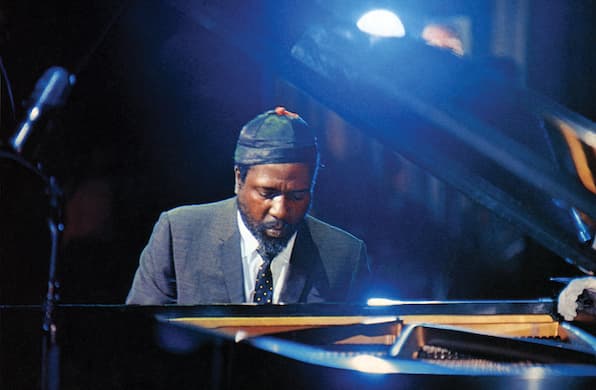Thelonious Monk’s Personality on Full View in New Release
The 1963 Tokyo performance captures Monk’s humor, not to mention his amazing sense of melody, harmony, and rhythm. In addition to the album, footage is available for viewing on YouTube.

Thelonious Monk
‘The Classic Quartet’
Candid Records
There’s a story, possibly apocryphal, about Thelonious Monk and his 1956 composition “Ba-Lue Bolivar Ba-Lues-Are.” Supposedly, Monk performed the number at a club and afterward, a rather dignified South American gentleman walked up to him and said, “Thank you for naming that composition for our great hero, Simón Bolívar.” Monk responded, “Actually, I got the name from a hotel.”
My father related that to me, and the only part of it that’s verifiably true is that Monk did indeed name the song after Midtown Manhattan’s Bolivar Hotel, the temporary home of his great friend and patroness, Pannonica de Koenigswarter.
Still, my dad was close enough to the jazz scene at the time, and, since I never heard that story anywhere else, even in Robin DG Kelley’s definitive biography of the pianist and composer, I like to think he might have been there when it allegedly happened.
“Ba-Lue Bolivar Ba-Lues-Are” is one of Monk’s best blues tunes, along with the more famous and less treacherously titled “Blue Monk.” Both are part of “The Classic Quartet,” a new release of an excellent, lesser known set from Monk’s first visit to Japan, in 1963. It features what was then Monk’s working group, with tenor saxophonist Charlie Rouse, bassist Butch Warren, and drummer Frankie Dunlop.
True or not, the story about Monk and the South American is pertinent because it illustrates Monk’s acerbic wit, which is somehow very subtle and very broad at the same time. It seems entirely in keeping with his music that the man who came up with such quirky, off-beat melodies as “Nutty,” “Bye-Ya,” and “Bemsha Swing” would have such a quirky, off-beat sense of humor.
The 1963 Tokyo performance captures Monk’s humor, not to mention his amazing sense of melody, harmony, and rhythm. This was originally produced as a TV concert, with the quartet performing five numbers in a studio without an audience. There’s a low-res copy available for viewing on YouTube, but the audio on this new LP and CD release is superb.
Still, the video, it must be admitted, does add a lot. The first number on it is “Evidence” (on the album it’s “Epistrophy”), and it gives a wonderful if very murky glimpse of one of jazz’s most legendary characters in action.
We begin with the distinctive opening notes of one of Monk’s best-known jazz standards, famously a contrafact built on the harmonic bones of “Just You, Just Me.” Rouse is in the foreground soloing, and Monk is accompanying him in the background, jabbing at the keyboard in a highly percussive way, almost as if it were a vibraphone, and producing exactly the right notes to accompany the saxophonist. In this group, it seems like all four members are soloing all the time, even when only one is in the spotlight.
About three minutes in, as Rouse continues, Monk gets up from the piano bench and starts to whirl around the stage. You might call it dancing, but I would argue it has more to do with Cab Calloway than Rudolf Nuryev; yes, it’s moving to the motion, but it’s equal parts conducting. He throws his body around in exaggerated, jerky movements that both inspire and capture the beat. Dunlop’s bass solo is also exaggeratedly rhythmic, while Warren’s drum solo is surprisingly melodic.
The one questionable aspect of the release is the title, “The Classic Quartet.” Monk hired Warren just before they left for Japan, and they worked together in this particular line-up for only a few months.
Still, “Epistrophy” further shows how this foursome breathe and move as one, much like a dance troupe — they all land on the beat at the exact right moment, like the Nicholas Brothers times two. Both the timing and the combined notes are also in perfect sync with each other, the quirky tonality of the harmony matches the slightly unexpected, offbeat nature of the rhythmic placement.
It’s also a real treat to have one of Monk’s solo standards — and yes, his selection of what hipster audiences considered to be hoary old chestnuts like “Just a Gigolo” was also regarded, at the time, as further evidence of his impish sense of humor. He doesn’t distort the tune, but leaves it clearly recognizable, even as he overlays levels of interpretation on top of it, the space-y chords and the even more space-y rhythms.
With anyone else, it would seem like a somewhat disingenuous attempt to take a sentimental old song and merely funk it up, but Monk makes it into something wholly different, something better than it was before, Louis Prima and Keely Smith notwithstanding.
In both sequences, the video and the album, “Gigolo” leads into a blues, both of which also start with Monk playing unaccompanied before the rest of the trio joins in. The title of “Ba-Lue Bolivar Ba-Lues-Are” has by now been shortened to the simpler “Bolivar Blues.” The Bolivar Hotel, at 230 Central Park South, has long since been converted into a condo, but both the building and the tune are still with us — Monk’s music especially so.

